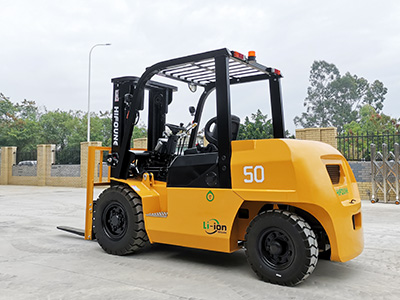The six major risks of charging
forklift batteries:
Mobile forklift batteries are very dangerous because lead-acid power batteries are very heavy. Usually, without some type of mechanical assistance, it is impossible to move or lift it into the charging station. Any device used to move batteries should be easy to move without the need for manual lifting or exaggerated body movements. Carefully check the appropriate lifting techniques and the weight limit that one person should lift.
2. Potential injury between pressure and injury. If the device used to move the battery does not have a fault protection device or other protective devices to prevent the battery from falling or moving uncontrollably, if the battery falls, it may harm employees. Requesting employees to stay away from the range of battery falls and wearing qualified steel toe safety work shoes and regulations can help avoid squeezing and pinching injuries.
3. Charging a battery can cause flammable gases. People often ask us, "Is the vapor in a rechargeable battery flammable?" Firstly, it is important to know that hydrogen gas is produced when charging the battery. Therefore, if the ventilation in the battery charging area is poor, the accumulation of hydrogen gas can cause an explosion hazard. In addition to providing ventilation and keeping the battery charging area clean without open flames or anything that may generate sparks, hydrogen monitors can also help ensure that combustible gases do not reach unsafe levels.
4. Forklift batteries contain corrosive electrolytes
Another question we often hear is: "What chemical hazards should we pay attention to when handling forklift batteries?"
The electrolyte in the battery contains sulfuric acid, which is corrosive and can cause chemical burns if splashed out from rechargeable batteries. Masks, goggles, gloves, and aprons help minimize injuries, especially when adding water after charging the battery. Eye washers or rain showers can also help quickly remove electrolytes and prevent further damage.
The routine procedure should also include removing electrolyte and dust from the battery box. Some facilities use sealed batteries to help minimize the chance of anyone coming into contact with electrolytes and reduce battery cleaning time.
5. Electrolyte splashing out can cause burns or slipping
Electrolyte splashing can cause chemical burns and pose a risk of slipping. Storing the spill prevention kit in the battery station and charging area helps with quick response, so that leaks can be quickly absorbed and eliminated. Employees should understand how to use personal protective equipment (PPE) and any neutralizing agents, tools, or equipment in the kit. Post instructions to remind you of the steps to take when cleaning up spilled battery acid.
6. The battery is fully charged
Like all batteries, lead-acid batteries also carry a charge and may generate an arc. A rule of thumb is that when the battery is in good condition, it should be charged when the battery capacity reaches about 30% of its capacity. Employees should remove any metal jewelry that may conduct electricity and be aware of any other metals in the area that may increase the risk of explosion.

